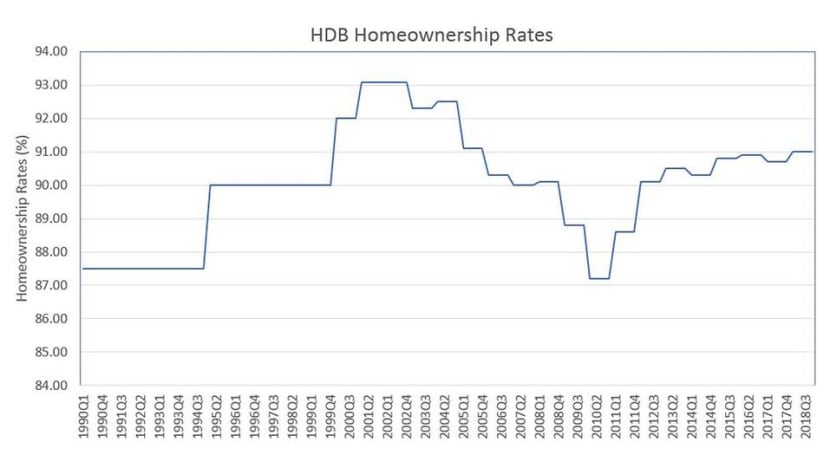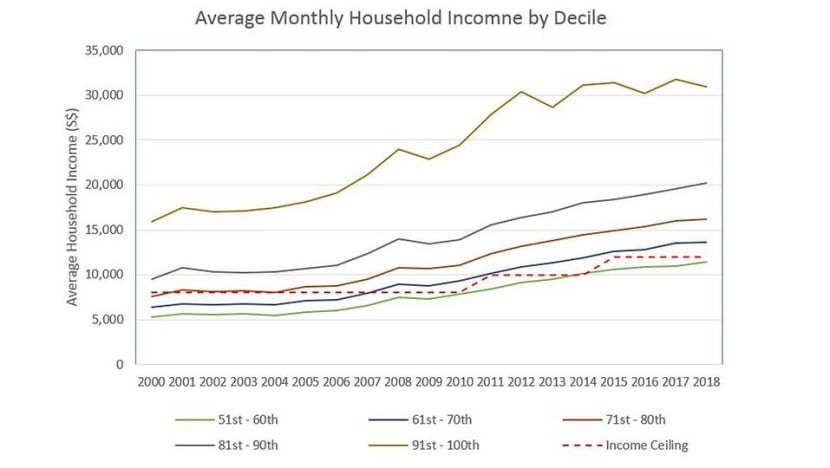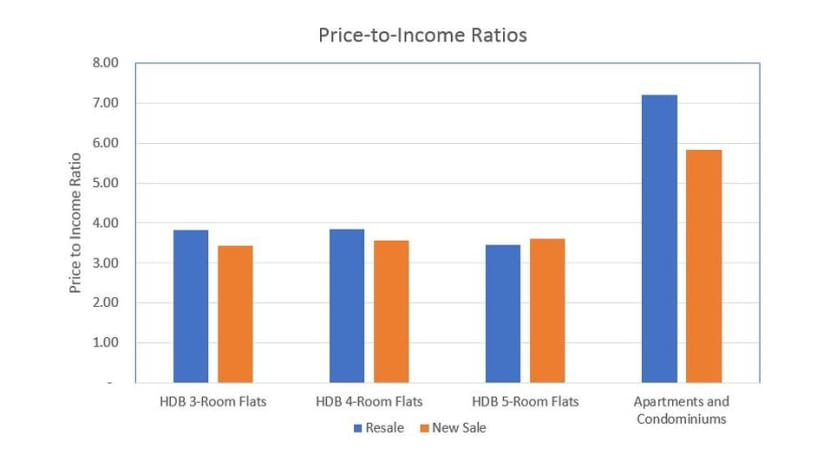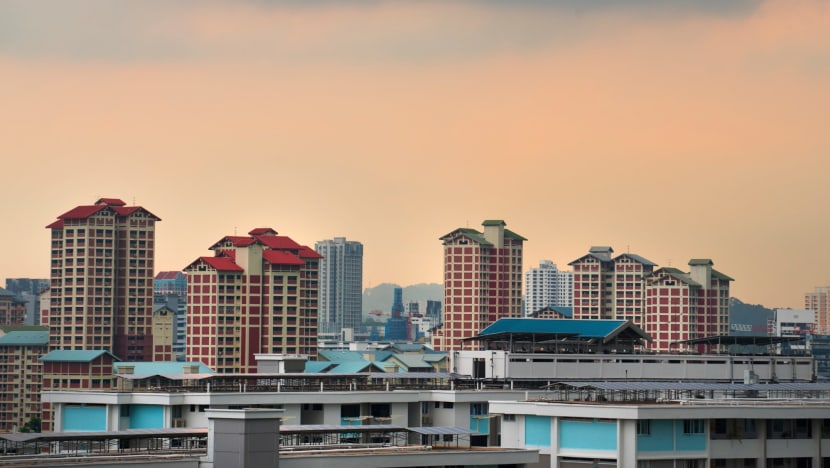commentary Commentary
Commentary: A look at HDB flat affordability after recent housing policy moves
NUS Director of the Institute of Real Estate and Urban Studies Sing Tien Foo gives his take on the effects of the new housing grant and higher income ceilings.

HDB flats along Punggol Waterway. (Photo: Wikimedia)
SINGAPORE: Public housing has played an important role in building a social compact that holds Singapore’s society together.
More than 78.7 per cent of resident households in Singapore live in flats built by the Housing and Development Board (HDB) in 2018.
In the Built-To-Order (BTO) market, which covers new public housing sales, HDB sells flats at concessionary prices to eligible households.
The BTO market meets housing needs for low- and middle-income households.
Many households earning above the median income are also eligible for BTO. The income ceiling of S$12,000 per month set by HDB way exceeds the national median income of S$9,293.

Going by average monthly income data, households between the 60th and 70th percentile will still meet this eligibility condition.
This figure improves to around the 75th percentile, with the raising of income ceilings to S$14,000, which took effect in September.
So it looks like the BTO market has just been expanded to cover about 75 per cent of Singapore resident households.
READ: Commentary: Would you want to raise a family in Singapore’s CBD?
GRANTS AND OTHER POLICIES ENSURE HOUSING AFFORDABILITY FOR ALL
Ensuring housing remains affordable has long been a key pillar of Singapore’s established social compact since independence.
The Government uses both demand-side and supply-side policies to keep new flats affordable.
The income ceiling has been an effective demand filtering mechanism designed to allow a targeted household segment to receive public housing subsidies.
These come in the form of direct financial grants – through the Additional CPF Housing Grants (AHG) and Special Housing Grants (SHG), disbursed to help families make partial payments in the purchase of new flats.
These two grants have since been replaced by the Enhanced CPF Housing Grants (EHG). The quantum ranging from S$5,000 to S$80,000 are linked to the income of first-timer families buying BTO flats.
The EHG caters specifically to those in the 50th percentile and below. Eligible first-timer families must not earn more than S$9,000 to qualify for the EHG.

On the supply side, the Government provides subsidies via the concessionary pricing scheme for new BTO flats. The level of subsidies is pegged to the flat type, such that buyers of smaller flats will receive more subsidies.
Since 2011, the Government moved another significant step to stabilise new BTO prices by delinking them from resale flat prices.
HDB then sets new flat prices based on a cost-plus basis. This approach allows HDB to better protect BTO flat buyers against price spillovers from the resale markets and their volatilities.
As a result, HDB can keep BTO flat prices affordable.
READ: 4,000 flats launched in first HDB sales exercise with higher grants, raised income ceilings
Past data suggest the housing prices of most HDB flats remain affordable. The price-to-annual income ratio remain below four in both BTO and resale public housing markets, based on the Department of Statistics’ latest data on income in 2018 and 2019 housing sale prices.
This figure is 7.21 and 5.83 for new and resale private non-landed housing markets respectively.
The numbers show a healthy level of affordability. A household needs to save four years’ worth of income (including CPF contributions) in order to purchase a new BTO flat, compared to seven years for private, non-landed housing.
READ: Commentary: The future of Singapore housing is in bigger HDB flats

This affordability is further boosted by the provision of the EHG.
INCOME CEILING INCREASE TARGETS SANDWICHED GROUP
The sandwiched group has benefitted most from revisions to the income ceiling over the years and will likely be most impacted by the latest increase.
A policy lever applied since 1964 to ensure public housing eligibility remains broad-based, adjustments to the income ceiling has been used periodically to ensure housing provision keeps pace with changing economic and market conditions.
The income ceiling was set at S$1,000 for 3-room HDB flats in 1965, a figure which reached S$5,000 by 1990.
In the early 1990s, when both the private and public housing market prices were rising steeply, the Government revised the income ceiling three times in four years from S$5,000 in 1990 to S$8,000 in 1994.
The S$8,000 ceiling then stayed for the next 17 years, before it was revised to $10,000 in 2011, S$12,000 in 2015 and S$14,000 in September.
It is unclear if the income ceiling revisions were entirely triggered by rising income levels or if the income ceiling increases fuelled an increase in housing prices.
What we can unambiguously establish is its wider coverage of sandwiched households, for whom private housing is a significant financial stretch.
The proportion of households earning S$8,000 and below (and were therefore eligible for a BTO) declined sharply from 71.6 per cent in 2000 to 38.1 per cent in 2018.
At the same time, the number of those who are not eligible for a BTO rose. The proportion of households earning between S$8,000 and S$14,000 and above S$14,000 surged to 24 per cent and 26 per cent, respectively in 2018.
In fact, the number of high-income families earning above S$14,000 has exceeded those in the middle decile after 2016.
My estimates show if the income ceiling of S$8,000 had not been raised in 2011, 2015 and this year, nearly one in four families earning between S$8,000 and S$14,000 today will be excluded from a BTO.
READ: Commentary: The Lease Buyback scheme can give singles more housing options

The recent relaxation of the income criteria in the BTO market thus eases the squeeze on sandwiched households, giving them an option to buy a BTO flat.
Another group of households earning between S$14,000 and S$16,000, which make up about 6.8 per cent of households, will additionally have access to executive condominiums as a housing option.
IMPACT ON THE PRIVATE HOUSING MARKET
Since BTO flat prices have been delinked from resale HDB prices, will the recent policies create spillover effects in the resale and private housing markets? There are two competing hypotheses.
First, if households in the S$12,000 to S$14,000 income decile decide to buy a flat instead of a private home, demand for private housing will decline, putting downward pressure on private housing prices.
On the contrary, if the extension of the EHG to the resale housing market drives demand and pushes up prices of older flats in the resale market, this may motivate more HDB owners to sell older flats and upgrade to private houses. In this case, the EHG policy may have the effect of increasing private housing prices.
Regardless of the projections here, the housing market needs time to react to these policy changes and it will be premature to reach a conclusive outcome on their effects.
But historical data from the resale HDB price index and URA private property price index shows strong interaction between both markets.
READ: Commentary: Who’s buying private property after last year’s cooling measures?

First, short-term deviations in the two prices have seen correction in their long-term price trends.
Second, the private housing market tends to respond more quickly to such policy shocks, with the resale public housing market lagging behind.
KEEPING PUBLIC HOUSING ACCESSIBLE
The dual housing market model comprising a large regulated public housing market and a small private housing market has worked well to maintain a stable supply of affordable housing for Singaporean households.
It is useful for housing policy to keep up with changes in income, housing preferences and family structures to ensure public housing remains accessible to the broad middle.
Thus far, the Singaporean Government’s active intervention in recent years has proven that public housing can fill the gap that private housing does not meet.
Associate Professor Sing Tien Foo is the Dean’s Chair and the Director of the Institute of Real Estate and Urban Studies, NUS.















